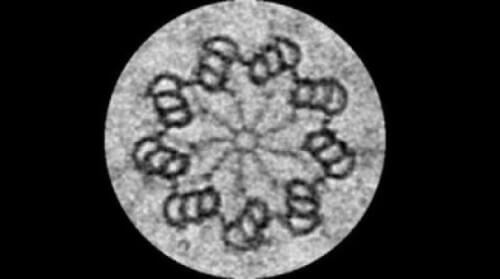Scientists from the Federal Polytechnic Institute in Lausanne, Switzerland (EPFL) discovered that cellular structures called centrioles can act as carriers of information between generations of cells. The discovery raises the possibility that the transfer of biological information can be carried out not only within the genes

Scientists from the Federal Polytechnic Institute in Lausanne, Switzerland (EPFL) discovered that cellular structures called centrioles (centrioles) can act as information carriers between generations of cells. The discovery raises the possibility that the transfer of biological information can be carried out not only within the genes. The centrioles may carry information with unprecedented implications for biology and disease treatment.
The centrioles are barrel-shaped structures found inside the cells, and are made of different types of proteins. They are currently the focus of many studies because mutations in the proteins that make them up can cause a variety of diseases, including developmental defects, respiratory diseases, male infertility and cancer. The findings were published in the journal Cell Research from the Nature group.
EPFL scientists have shown that the original centrioles found in the fertilized egg, which come exclusively from the father, survive dozens of cell divisions in developing embryos. This important finding raises the possibility that the centrioles may also be carriers of information with implications for biology and the treatment of diseases whose well-known role in cell division is to ensure that the chromosomes are successfully transferred to the new daughter cells. However, they are also found in cilia (eyelashes), structures that resemble eyelashes that allow many of the cells in the body to signal to their neighbors and other cells to move, for example in rows of cells in the trachea.
During fertilization, both parents contribute more or less equal genetic material, with the mother's egg contributing most of the organelles in the cell, such as the mitochondria. However, the centrioles of a new embryo come mainly from the male's sperm, and they bring with them every hereditary defect to the first embryo cells.
The researchers in the laboratory of Pierre Gonchi at the Swiss Institute for Experimental Cancer Research of the EPFL discovered that centrioles can transmit the information not only to the first cells but to many of the developing embryonic cells over several cell generations. The research was done in the C. elegans worm, which is widely used as a model animal for fetal development and human genetic diseases. As in other species, including humans, the centrioles of C. elegans are donated solely by the sperm cell. Gonchi's team wanted to know how well the "original" centrioles survive the frequent cell divisions that turn a fertilized egg into a full-fledged embryo.
To track the fate of the centrioles, the scientists used genetically modified worms in which they could tag three centriole proteins with fluorescent markers. The marked males were fertilized with unmarked females, so that the scientists could uniquely track the components of the centrioles that, as mentioned, passed from the father during the fertilization stage.
The researchers photographed the fluorescent signals at different divisions of the embryo's development, and discovered that the centriole proteins donated by the father persisted through ten cell generations. The data showed for the first time that the centrioles are impressively resistant in the developing embryo.
An even more interesting thing are the implications of the research for biology in general, when it shows that the centrioles, during several cell cycles, can be effective carriers of non-genetic information. If confirmed, it may change the paradigm in the way we think about and understand the biology of the organelles found in all eukaryotic animals throughout evolution.
Of course, this will not detract from the value of medical research. Given the number of diseases associated with cetanirioles, this could open up a new path in approaches to innovative treatments. In particular, the study demonstrates how damaged centrioles can pass directly from the father deep into fetal life. This has implications for our way of understanding centriole-related diseases.
"Centrioles have always been seen as something that initiates the development of the embryo" says Pierre Gonchi. "Here we show what centrioles may mean for the inheritance of information, with a significant impact on initial development."
His team members will next investigate whether the centrioles' extraordinary survival extends to other systems, including human cells.
For the announcement of the Polytechnic Institute in Lausanne

4 תגובות
Proofread! I love you very much but it's hard to read. You broke me in C Elegantes
As soon as we understand that everything has a level of consciousness that is also related to and affected by our state of consciousness and feelings, it will be easier for us...
What information can they convey except the proteins themselves that they are made of?
What do you mean? The centrioles do not divide with the cells? Is it possible for some of the daughter cells of a cell that has divided to contain centrioles and some not? How is the process organized?